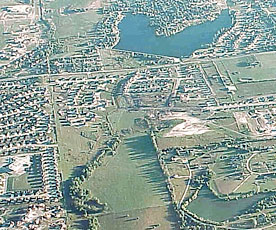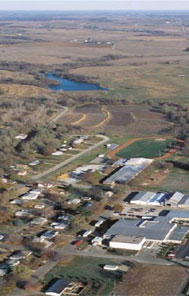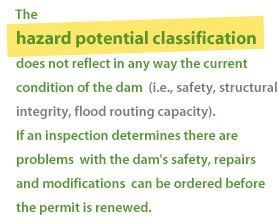About EAPs
What is a High-Hazard Potential Dam?
Each state has definitions and methods to determine the Hazard Potential of a dam. The Hazard Potential is defined as a situation which creates the potential for consequences such as loss of life, property damage, or other adverse impacts.
 Neighborhood association dams in suburban communities can be a significant risk to downstream residents and their homes, workers and their businesses, and even those who may be merely passing through the area.
Neighborhood association dams in suburban communities can be a significant risk to downstream residents and their homes, workers and their businesses, and even those who may be merely passing through the area.

Extensive development downstream from dams in rural areas will increase the risk to lives and property in the event of a dam failure.
These adverse impacts may occur in a defined area downstream of a dam because of flood-waters released through spillways and outlet works of the dam or because of waters released by partial or complete failure of the dam. Adverse impacts also may occur upstream of the dam from effects of backwater flooding or landslides around the reservoir perimeter.
In Georgia, dams are regulated by the state if they are 25 feet or more in height or impound 100 acre-feet or more. Exceptions include some federal dams, and those less than 6 feet in height regardless of storage capacity or which have storage capacity of less than 15 acre-feet regardless of height. The height of a dam is from the lowest point on the crest of the dam to the lowest point on the downstream toe, and the storage capacity is the volume impounded at the crest of the dam. (See this website's glossary for further terms and definitions.)
Safe Dams Program engineers determine the "hazard potential" of a dam, meaning the probable damage that would occur if the structure failed, in terms of loss of human life. Dams are assigned one of two classes based on the nature of their hazard potential:
- CATEGORY I dams are those for which improper operation or dam failure would result in probable loss of human life. Situations constituting "probable loss of life" are those situations involving frequently occupied structures or facilities, including but not limited to, residences, commercial and manufacturing facilities, schools, and churches.
All Category I dams are sub-classified as follows:
- Small dams – those with a storage capacity not exceeding 500 acre-feet and a height not exceeding 25 feet.
- Medium dams – those with a storage capacity exceeding 500 acre-feet but not exceeding 1,000 acre-feet or a height exceeding 25 feet but not exceeding 35 feet.
- Large dams – those with a storage capacity exceeding 1,000 acre-feet but not exceeding 50,000 acre-feet or a height exceeding 35 feet but not exceeding 100 feet.
- Very large dams – those with a storage capacity exceeding 50,000 acre-feet or a height exceeding 100 feet.
- CATEGORY II dams are those for which improper operation or dam failure would not be expected to result in probable loss of human life.
 The classification of dams can be changed if the hazard potential has changed. Flood plain zoning and early warning systems may be considered in making this determination. When dams are spaced so that the failure of an upper dam would likely cause failure of a lower dam ("cascading"), the consequence of the lower dam's failure determines the upper dam's hazard classification.
The classification of dams can be changed if the hazard potential has changed. Flood plain zoning and early warning systems may be considered in making this determination. When dams are spaced so that the failure of an upper dam would likely cause failure of a lower dam ("cascading"), the consequence of the lower dam's failure determines the upper dam's hazard classification.
Inspections, Exemptions, Laws and Regulations
All state-regulated Category I HHP dams are inspected at least once every two years. All Category II dams are inspected at least once every five years. At any time an inspection indicates that a dam may not perform satisfactorily or that the hazard classification has changed, a detailed investigation is conducted to determine any required remedial action.
Not all dams 25 feet or more in height fall under state regulation in Georgia. Dams constructed, licensed and maintained by the Tennessee Valley Authority or by U.S. government agencies are usually exempt from state regulation unless the agency has relinquished operation and maintenance of the dam to a local entity.
The fact that a dam does not fall within the inspection jurisdiction of the Safe Dams Program does not mean it is safe. State dam safety regulators note that many of Georgia's unregulated, private dams have gone unchecked for decades. Dams that do not get regular inspections can erode over the years, or be damaged by floods. Some of these potentially hazardous dams are several miles from a downstream city that would be threatened by a failure.
Laws governing the Georgia Safe Dams Program are embodied in the "Georgia Safe Dams Act of 1978", (O.C.G.A. 12-5-370 through 12-5-385) last amended in 1990. Rules are found in Chapter 391-3-8 of the Rules of the Department of Natural Resources Environmental Protection Division, last amended in 1998.
